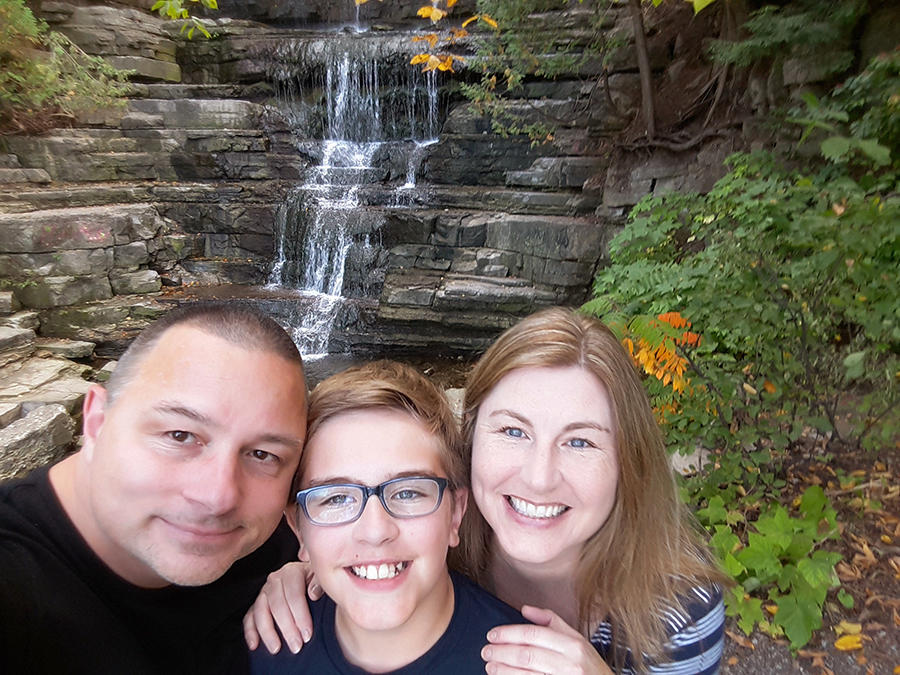Deciding If and When to Have Surgery for a Spine Tumor
, by Beth, Spinal Cord Tumor Survivor
Beth discovered a tumor in the center of her spinal cord and the only treatment was surgery. She shares how she found expert care, support, and resources to help her make a decision.
I am in the middle of my journey with a rare spine tumor. My tumor was discovered incidentally in 2019. I was having symptoms related to my spine—pain, stiffness, and loss of mobility. A magnetic resonance imaging (MRI) scan revealed a tumor located in the middle of my cervical spine. Once it was discovered, I was referred to a neurosurgeon close to my home in Ottawa, Canada. There, I was diagnosed with what was likely an intramedullary spinal ependymoma and a syrinx (a fluid-filled cavity within the spinal cord).
While it was not a large tumor, it was in the center of my spinal cord and the only treatment was surgery. A biopsy was not an option. My husband and I found ourselves trying to wrap our heads around this devastating news and trying to make decisions without having all the details. We did not have a definitive diagnosis, and we were unsure of the stage of cancer or how fast it was growing. In addition, as there isn’t a center that specializes in spinal neurosurgery near us, we began researching our treatment options.
Get Multiple Opinions
Thankfully, my symptoms were stable, giving us time to do our own research. My husband and I began exploring support groups and reading every recently published article we could find. We found support through social media, NCI-CONNECT, the Collaborative Ependymoma Research Network (CERN) Foundation, and by reaching out to other patients and survivors. My neurosurgeon ordered another MRI and confirmed there was no growth in the last few months. Around this time, I began experiencing weakness in my arm.
We found ourselves stuck between the “wait and see” approach and moving forward with surgery. When weighing our options, we felt paralyzed by the gravity of the decision. My neurosurgeon proposed moving ahead with the surgery right away. But, based on the research we had done, we felt strongly that we should get a second opinion. Even if the second opinion agreed, at least I would feel more confident in the decision.
We found the Natural History Study, led by the NCI Center for Cancer Research's Neuro-Oncology Branch (NOB), and decided it was worth investigating further. I first met with NOB Neuro-Oncologist Marta Penas-Prado, M.D., at NIH for an initial consultation. We discussed the ependymoma diagnosis, the necessity of spinal surgery, and the possibility of taking a more passive approach and watching the tumor with imaging. Dr. Penas-Prado shared that central nervous system (CNS) tumors like mine eventually cause deficits, so surgery was in my future. We understood that if I could have many years with relatively normal functions without pain, it might be worth waiting, but it cannot be put off indefinitely. We discussed the benefits of having the surgery sooner, and the process of recovery. Dr. Penas-Prado patiently answered our long list of questions and helped us come to grips with this life-changing diagnosis.
My husband and I also met with neurosurgeon John Heiss, M.D., of the National Institute of Neurological Disorders and Strokes (NINDS) at NIH to discuss the surgery and options. Although my tumor is small, it is located inside my spinal cord at the C5-C6 vertebrae, so the surgery comes with significant risks such as paralysis and other long-term deficits. We found ourselves in the tricky spot where this serious surgery is inevitable, but—at the moment—not an emergency.
Looking back, we are so thankful that we took control and got multiple opinions, which should be standard for people with a rare spine tumor diagnosis.
This was the best thing we could have done. All the providers agreed on the probable diagnosis and potential treatment plan, but we felt reassured by the NIH team. Their suggestions felt objective yet authoritative—and as though they were genuinely invested in my outcome. Drs. Heiss and Penas-Prado had experience dealing with patients who have rare CNS cancers, which was comforting. Finally, I felt hopeful.
Weigh the Benefits and Risks
I have now visited the NIH twice for scans and appointments. Thankfully, my symptoms and scans are stable. Currently, I am experiencing localized pain in my neck, bad headaches, and muscle pain. I also have some numbness and muscle weakness in my leg and arm. Overall, the symptoms are considered mild and the pain is fairly manageable.
We still face the decision of when to move forward with the operation. Naturally, I am frightened of having surgery and the difficult recovery, knowing that the resulting deficits will likely be worse than the symptoms I am experiencing now. On the flipside, if I wait too long then I have a higher risk of further deficits. Having the surgery will also allow us to get the pathology needed to determine if I need further treatment and the likelihood of the cancer spreading. I find myself reviewing my symptoms every day and evaluating my progress. It's hard not to worry.
I think it's normal to feel helpless when you are first diagnosed with a serious illness, but I believe this just highlights the importance of finding the right medical team for guidance. So far, this journey has taught us how lucky we are to have such a loving family and group of friends. We leaned on them heavily as we went through this difficult time. Once I gained some control of the situation by fully understanding this diagnosis, I became more optimistic. Finding the right experts and resources allowed me to feel positive, and I now have the strength to fight the battles ahead.
